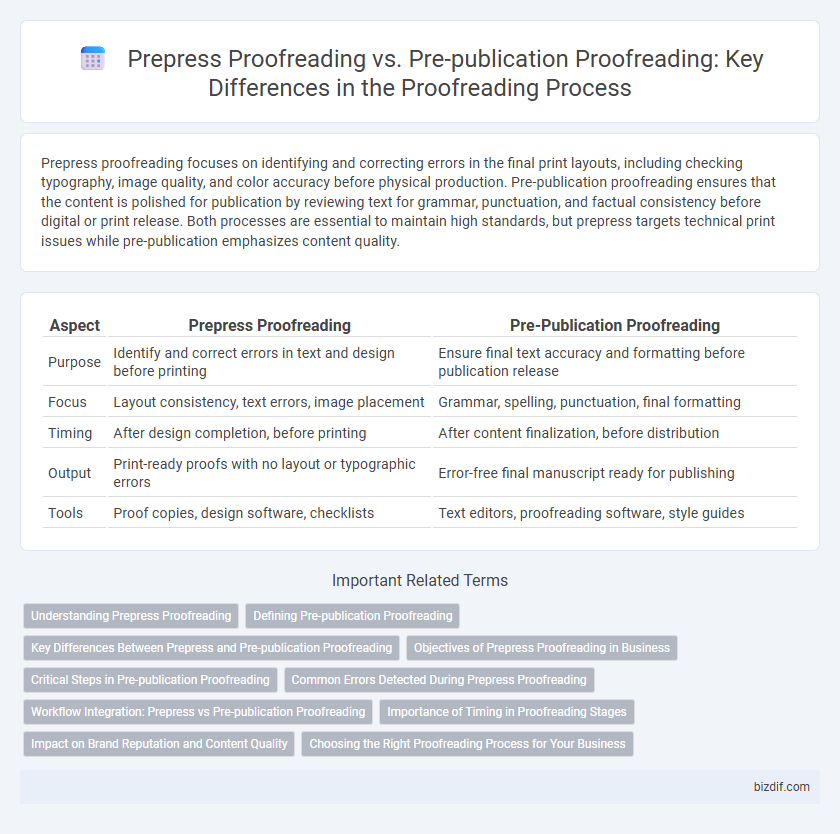Prepress proofreading focuses on identifying and correcting errors in the final print layouts, including checking typography, image quality, and color accuracy before physical production. Pre-publication proofreading ensures that the content is polished for publication by reviewing text for grammar, punctuation, and factual consistency before digital or print release. Both processes are essential to maintain high standards, but prepress targets technical print issues while pre-publication emphasizes content quality.
Table of Comparison
| Aspect | Prepress Proofreading | Pre-Publication Proofreading |
|---|---|---|
| Purpose | Identify and correct errors in text and design before printing | Ensure final text accuracy and formatting before publication release |
| Focus | Layout consistency, text errors, image placement | Grammar, spelling, punctuation, final formatting |
| Timing | After design completion, before printing | After content finalization, before distribution |
| Output | Print-ready proofs with no layout or typographic errors | Error-free final manuscript ready for publishing |
| Tools | Proof copies, design software, checklists | Text editors, proofreading software, style guides |
Understanding Prepress Proofreading
Prepress proofreading involves meticulously checking print materials for errors in layout, color accuracy, fonts, and image resolution before the printing process begins. This step ensures that all design elements align with printer specifications, preventing costly mistakes and print defects. Understanding prepress proofreading is essential to guarantee that the final printed product meets quality standards and maintains brand consistency.
Defining Pre-publication Proofreading
Pre-publication proofreading involves the final review of text and design before printing or digital release, ensuring error-free content and consistent formatting. This stage targets typographical mistakes, grammatical errors, and layout issues to maintain the highest quality standards. Unlike prepress proofreading, pre-publication proofreading emphasizes textual accuracy and overall readability to guarantee a polished final product.
Key Differences Between Prepress and Pre-publication Proofreading
Prepress proofreading primarily concentrates on identifying printing errors such as color mismatches, layout inconsistencies, and text alignment issues before the printing process begins. Pre-publication proofreading focuses on correcting grammatical errors, factual inaccuracies, and content consistency to ensure the final text meets editorial standards prior to release. The key difference lies in prepress targeting technical print production issues, while pre-publication emphasizes linguistic accuracy and content verification.
Objectives of Prepress Proofreading in Business
Prepress proofreading in business focuses on detecting and correcting errors in text, images, and layout before printing to ensure brand consistency and avoid costly production mistakes. It aims to verify accuracy, maintain quality standards, and confirm adherence to client specifications, reducing the risk of reprints and customer dissatisfaction. This process supports seamless communication between design and printing teams, enhancing overall operational efficiency.
Critical Steps in Pre-publication Proofreading
Pre-publication proofreading involves critical steps such as verifying final page layouts, checking for typographical errors, and ensuring consistency in font styles, colors, and image placements before printing. Unlike prepress proofreading, which centers on technical aspects like file formatting and plate-making accuracy, pre-publication proofreading focuses on the content's visual integrity and error-free presentation. This stage is essential to prevent costly mistakes and maintain brand standards in printed or digital materials.
Common Errors Detected During Prepress Proofreading
Common errors detected during prepress proofreading primarily include color inaccuracies, image resolution flaws, and font inconsistencies that can affect the final print quality. This stage also identifies layout misalignments, missing or incorrect bleeds, and trapped elements that are crucial for seamless printing. Ensuring precision in these technical details prevents costly printing errors and maintains brand integrity before the production process begins.
Workflow Integration: Prepress vs Pre-publication Proofreading
Prepress proofreading is integrated into the production workflow, ensuring early detection of errors in design, layout, and text before printing plates are created. Pre-publication proofreading occurs later, focusing on final content accuracy and consistency prior to digital or print release. Streamlining these stages reduces costly revisions and enhances overall publication quality.
Importance of Timing in Proofreading Stages
Prepress proofreading occurs early in the production process to catch and correct errors before printing plates are made, ensuring cost-effective corrections and preventing delays. Pre-publication proofreading happens after final layout approval, focusing on last-minute errors to maintain content accuracy and quality before distribution. Proper timing in these proofreading stages is crucial to optimize workflow efficiency and maintain the integrity of the published material.
Impact on Brand Reputation and Content Quality
Prepress proofreading ensures accuracy in design elements, color consistency, and layout, directly preventing costly errors that can damage brand reputation before printing. Pre-publication proofreading focuses on textual correctness and factual accuracy, enhancing content quality and reader trust prior to distribution. Both processes are crucial for maintaining a professional image and delivering high-quality, error-free materials that uphold brand integrity.
Choosing the Right Proofreading Process for Your Business
Prepress proofreading focuses on identifying errors in design elements, layout, and typesetting before printing, ensuring the accuracy of graphics and text alignment for physical production. Pre-publication proofreading targets final content review, correcting typographical, grammatical, and factual errors before digital or print release to the audience. Choosing the right proofreading process depends on your business needs: select prepress proofreading to prevent costly printing mistakes, and pre-publication proofreading to guarantee polished, error-free published materials.
Prepress proofreading vs Pre-publication proofreading Infographic

 bizdif.com
bizdif.com